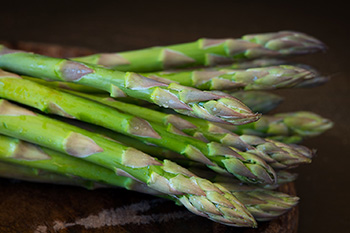
Asparagus Description & Health Benefits
- Asparagus is a member of the Asparagaceae botanical family. Multiple varieties exist. Green or violet-green varieties are most commonly found in the U.S.; white asparagus is favored in Europe.
- Asparagus is naturally cholesterol free and low in calories and fat. It is an excellent source of vitamin K and folate, and a good source of vitamin A, vitamin C, riboflavin, and thiamin.
- Vitamin K is important in blood clotting and bone building.
- Folate is used to create DNA and other genetic material. Adequate folate intake is essential for women who plan to become pregnant as it reduces the risk of neural tube defects.
- Vitamin A supports the immune system, healthy vision, and reproduction.
- Vitamin C encourages iron absorption and promotes wound healing. It also helps to maintain and repair bones, teeth and cartilage.
- Riboflavin is essential for growth and red blood cell formation.
- Thiamin helps our bodies convert the carbohydrates we eat (grains, vegetables, fruits, milk) into energy the body uses for daily living.
Purchasing, Selecting, Storing, and Preparing
- Purchase fresh, frozen or canned. In the United States, asparagus season is typically March through June. Visit your local farmers market this spring to find freshly harvested asparagus.
- Select asparagus spears that are firm but tender. The tips should be compact and closed. Avoid spears that are limp, wilting, blemished or those in which the tips are flowering. Always check the ends of the asparagus spears to ensure they are moist; avoid those that look cracked or woody.
- Asparagus is best eaten when it is freshly picked, but can be stored in the refrigerator for up to five days. Place a damp paper towel around the ends of the asparagus and place in a paper bag in the crisper drawer to extend the quality if you are unable to consume right away.
- Prepare by rinsing under cold water and cutting an inch off the stem, then steam, boil, roast, grill, sauté, or eat raw.
Nutrition Facts
1/2 cup cooked, boiled, or drained
Calories: 20 | Protein: 2.16 g | Fat: 0.20 g | Carbohydrate: 3.70 g | Fiber: 1.8 g | Calcium: 21 mg | Magnesium: 13 mg | Potassium: 202 mg | Vitamin C: 6.9 mg | Folate: 134 μg | Vitamin A: 905 IU
ndb.nal.usda.gov
Recipes
Request an Appointment
